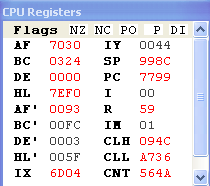Back to menu
CPU Registers

You can see the values in the different CPU
registers or counters.
On the Z80, these registers or counters are
called: A, B, C, D, E, F, H, L, IX, IY, SP,
PC, I, R, IM, CLH, CLL, CNT.
There are also shadow registers : A', B', C',
D', E', F', H', L', useful to swap values
with the normal registers.
A is the accumulator, it's the most
important register.
As the Z80 is an 8-bit processor, the A, B, C, D,
E, H, L registers can hold any value from 0-255
(= 8 bit or one byte).
To store larger numbers, you can combine a few of
them: BC, DE, HL. The result is a 16 bit
register, having a range from 0-65535.
F is the flag register, it contains
flags which store certain conditions after
executing opcodes :
| Z |
|
zero flag (Z = zero
flag set / NZ = not set) |
| C |
|
carry flag (C = carry
flag set / NC = not set) |
| P |
|
parity flag (PE = even
/ PO = odd) also used as overflow flag |
| S |
|
sign flag (P = plus /
M = minus) |
If you change the flags, you can see the
result in the AF register.
I is the interrupt register that contains
the upperword of the interrupt table. Its flag
indicates if the interrupts are enabled (EI) or
disabled (DI)
IX and IY are mostly used as
auxiliary HL and can be used as index fields.
SP is the stackpointer, it's a very
important register, though it's changed most of
time indirectly by PUSHing/POPing values to/from
the stack.
PC is a program counter, to keep track
of where the Z80 is getting instructions from.
R is the memory refresh register. After
each instruction, it'll be incremented. It can be
used as a poor random number generator.
IM is the interrupt mode register. Value
can be 0, 1 or 2.
CLH is the high 16 bits of
the CPU clock counter, CLL is the low 16
bits of the CPU clock counter (so the current
clock counter is 65536 * CLH + CLL) and CNT is
an instruction counter. These values may come in
handy while debugging.
Back to menu
|
|
